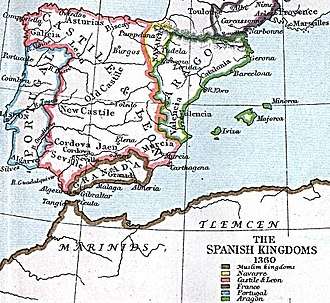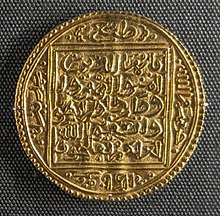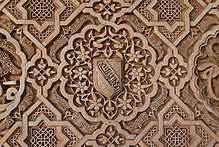Emirate of Granada
The Emirate of Granada (Arabic: إمارة غرﻧﺎﻃﺔ, trans. Imārat Ġarnāṭah), also known as the Nasrid Kingdom of Granada (Spanish: Reino Nazarí de Granada), was an Islamic realm in southern Iberia during the Late Middle Ages. It was the last independent Muslim state in Western Europe.[1]
Emirate of Granada إمارة غرﻧﺎﻃﺔ Imarat Gharnāṭah | |||||||||
|---|---|---|---|---|---|---|---|---|---|
| 1230–1492 | |||||||||
 Flag
.svg.png) Coat of arms
| |||||||||
 Territory of the Nasrid Kingdom from the 13th to 15th centuries | |||||||||
| Status | Tributary state of the Crown of Castile (intermittent) | ||||||||
| Capital | Granada | ||||||||
| Common languages | Official language: Classical Arabic Other languages: Andalusi Arabic, Mozarabic, Berber, Ladino | ||||||||
| Religion | Majority religion: Sunni Islam Minority religions: Roman Catholicism Judaism | ||||||||
| Government | Hereditary monarchy | ||||||||
| Sultan | |||||||||
• 1238–1273 | Muhammad I | ||||||||
• 1487–1492 | Muhammad XII | ||||||||
| Historical era | Late Middle Ages | ||||||||
• Established | 1230 | ||||||||
| 1492 | |||||||||
| |||||||||
| Today part of | |||||||||
| History of Al-Andalus |
|---|
|
Muslim conquest (711–732) |
|
Umayyads of Córdoba (756–1031) |
|
|
First Taifa period (1009–1110) |
|
Almoravid rule (1085–1145) |
|
Second Taifa period (1140–1203) |
|
Almohad rule (1147–1238) |
|
Third Taifa period (1232–1287) |
|
Emirate of Granada (1238–1492) |
| Related articles |
Muslims had been present in the Iberian Peninsula, which they called Al-Andalus, since the early eighth century. At its greatest geographical extent, their territory occupied most of the peninsula and part of present-day southern France.[2] From the ninth to tenth century, under the Caliphate of Cordoba, the region was one of the most prosperous and advanced in Europe. Conflict with the northern Christian kingdoms was recurrent, while mounting civil strife led to a fragmenting of Muslim states in the early eleventh century. This marked a precipitous decline in Muslim power and hastened the centuries-long Christian Reconquista.
By 1230, the Almohad Caliphate in Morocco ruled the remaining Muslim territories in southern Iberia, which roughly corresponded to the modern Spanish provinces of Granada, Almería, and Málaga. Exploiting the Almohad's dynastic strife, the ambitious Muhammad ibn al-Ahmar rose to power and established the Nasrid dynasty over these lands. By 1250, the emirate was the last Muslim polity in the peninsula. Although effectively a vassal of the rising Crown of Castile, for over two centuries, Granada enjoyed considerable cultural and economic prosperity; much of the famed Alhambra palace complex was built during this period, and the Nasrids would be the longest-lived Muslim dynasty in Iberia.
Nascent Christian power in Iberia meant that Granada's existence was always precarious. In 1491, after a decade of intermittent warfare known as the Granada War, the emirate was forced to capitulate to the Catholic Monarchs. The following year, Muhammad XII, the last Nasrid ruler of Granada, formally relinquished his sovereignty and surrendered his territories to Castile, eventually moving to North Africa in exile. This marked the end of independent Muslim rule in Iberia, and the decline of Muslim presence.
Tributary state
With the Reconquista in full swing after the conquest of Córdoba in June 1236, Mohammed I ibn Nasr aligned Granada with Ferdinand III of Castile in 1246,[1] thereby creating a tributary state, or taifa, under the Crown of Castile. Granada remained a tributary state for the next 250 years, with Nasrid emirs paying tribute to Castilian kings mostly in the form of gold from present-day Mali and Burkina Faso that was carried to Iberia through the merchant routes in the Sahara. The Nasrids also provided military assistance to Castile for its conquest of areas under Muslim control, most notably Seville in November 1248 and the Taifa of Niebla in 1262.
In 1306, Granada conquered Ceuta, but lost control of the city in 1309 to the Kingdom of Fez with the assistance of the Crown of Aragon. Granada re-captured Ceuta a year later, but again lost it in 1314. Granada again held the city from 1315 to 1327. In 1384, Granada again re-took Ceuta but lost it definitively to Kingdom of Fez in 1386. Finally Ceuta was taken by the Portuguese Empire in 1415 and by the Spanish Empire in 1580.
Granada's peace with Castile broke down on various occasions. Granada lost territory to Castile at the Battle of Teba in 1330. In 1340, Granada under Yusuf I supported the failed Marinid invasion of the Iberian Peninsula, which ended at the Battle of Río Salado.
Regional entrepôt

Granada's status as a tributary state and its favorable geographic location, with the Sierra Nevada as a natural barrier, helped to prolong Nasrid rule and allowed the Emirate to prosper as a regional entrepôt with the Maghreb and the rest of Africa. The city of Granada was one of the largest cities during this time: it accepted numerous Muslim refugees expelled from Christian controlled areas, doubling the size of the city[3] and even becoming the largest city of Europe in 1450 in terms of population. During this time there were 137 mosques in the Medina of Granada.[4] Granada also served as a refuge for Muslims fleeing during the Reconquista. Regardless of its comparative prosperity, intra-political strife was constant. Skirmishes along the border of Granada occurred frequently and territory was gradually lost to Castile.
Granada was tightly integrated in Mediterranean trade networks and heavily financed by Genoese bankers aiming to gain control of the gold trade carried in through Trans-Saharan trade routes.[5] However, after Portugal opened direct trade routes to Sub-Saharan Africa by sea in the 15th century, Granada became less important as a regional commercial center. With the union of Castile and Aragon in 1469, these kingdoms set their sights on annexing Granada.

Fall of Granada
The war of Granada would offer an opportunity for Ferdinand and Isabella to harness the restless Castilian nobility against a common enemy and instill subjects with a sense of loyalty to the crown.[6] The Emirate's attack on the Castilian frontier town of Zahara in December 1481 led to a prolonged war.[6] The Granada War began in 1482, with Christian forces capturing Alhama de Granada in February 1482. This marked the beginning of a grinding 10-year war. The Christian force was made up of troops provided by Castilian nobles, towns, and the Santa Hermandad, as well as Swiss mercenaries.[7] The Catholic Church also encouraged other Christian countries to offer their troops and their finances to the war effort. Meanwhile, civil war erupted in Granada as a result of succession struggles in the Nasrid ruling house. Castile used this internal strife as an opportunity to push further into Granada. By 1491, the city of Granada itself lay under siege. On November 25, 1491, the Treaty of Granada was signed, setting out the conditions for surrender. On January 2, 1492, the last Muslim leader, Muhammad XII, known as Boabdil to the Spanish, gave up complete control of Granada, to Ferdinand and Isabella, Los Reyes Católicos ("The Catholic Monarchs").
Aftermath
The Christian ousting of Muslim rule on the Iberian Peninsula with the conquest of Granada did not extinguish the spirit of the Reconquista. Isabella urged Christians to pursue a conquest of Africa.[8] About 200,000 Muslims are thought to have emigrated to North Africa after the fall of Granada. Initially, under the conditions of surrender, the Muslims who remained were guaranteed their property, laws, customs, and religion. This however, was not the case, causing the Muslims to rebel against their Christian rulers, culminating with an uprising in 1500. The rebellion was seen as a chance to formally end the treaty of Granada, and the rights of Muslims and Jews were withdrawn. Muslims in the area were given the choice of expulsion or conversion. In 1568–1571, the descendants of the converted Muslims revolted again, leading to their expulsion from the former Emirate to North Africa and Anatolia.
For Jews as well, a period of mixed religious tolerance and persecution under Muslim rule in Spain came to an end with their expulsion by the Christian monarchy in 1492.
Culture
Literature
Ibn al-Khatib was a polymath and poet of the Nasrid period. He authored many works in various fields, and his poetry is carved into the walls of the Alhambra palace.[9]
Architecture

The Alhambra palace in Granada was expanded in the Nasrid period, particularly during the rule of Yusuf I and Muhammad V.[10]
Music
Gharnati music (الطرب الغرناطي) is a variety of Andalusi music that originated Granada and moved to North Africa where it survives to this day.[11]
List of sultans of Granada
| Years | Ruler | Reign |
|---|---|---|
| 1238–1272 | Muhammad I ibn Nasr | |
| 1273–1302 | Muhammad II al-Faqih | |
| 1302–1309 | Muhammad III | |
| 1309–1314 | Nasr | |
| 1314–1325 | Ismail I | |
| 1325–1333 | Muhammad IV | |
| 1333–1354 | Yusuf I | |
| 1354–1359 | Muhammad V | |
| 1359–1360 | Ismail II | |
| 1360–1362 | Muhammad VI | |
| 1362–1391 | Muhammad V | Second |
| 1391–1392 | Yusuf II | |
| 1392–1408 | Muhammad VII | |
| 1408–1417 | Yusuf III | |
| 1417–1419 | Muhammad VIII | |
| 1419–1427 | Muhammad IX | |
| 1427–1429 | Muhammad VIII | Second |
| 1430–1431 | Muhammad IX | Second |
| 1432-1432 | Yusuf IV | |
| 1432–1445 | Muhammad IX | Third |
| 1445–1446 | Yusuf V | |
| 1446–1448 | Muhammad X | |
| 1448–1453 | Muhammad IX | Fourth |
| 1453–1454 | Muhammad XI | |
| 1454–1461 | Sa'd | |
| 1462–1463 | Yusuf V | Second |
| 1464–1482 | Ali Abu'l-Hasan | |
| 1482–1483 | Muhammad XII Abu Abdallah | |
| 1483–1485 | Ali Abu'l-Hasan | Second |
| 1485–1486 | Muhammad XIII Abu Abdallah | |
| 1486–1492 | Muhammad XII Abu Abdallah | Second |
See also
- Nasrid dynasty
- Romance of Abenamar
- Taifa of Granada
- List of Sunni Muslim dynasties
- Border of Granada
References
- Miranda 1970, p. 429.
- Fernando Luis Corral (2009). "The Christian Frontier against al-Andalus (Muslim Spain): concept and politics during the reigns of King Fernando I of Castile and Leon and his successors until 1230". In Natalie Fryde; Dirk Reitz (eds.). Walls, Ramparts, and Lines of Demarcation: Selected Studies from Antiquity to Modern Times. LIT Verlag Münster. p. 67. ISBN 978-3-8258-9478-8.
- Granada- The Last Refuge of Muslims in Spain by Salah Zaimeche
- "Minaret of San Juan De Los Reyes and Mosque of The Conversos". legadonazari.blogspot.com. Retrieved 18 October 2018.
- Arrighi, Giovanni (2010). The Long Twentieth Century. Verso. p. 120. ISBN 978-1-84467-304-9.
- Barton, Simon (2004). A History of Spain. Palgrave Macmillan. p. 103. ISBN 978-0-230-20012-8.
- Barton, Simon (2004). History of Spain. Palgrave Macmillan. p. 104. ISBN 978-0-230-20012-8.
- Barton, Simon (2004). A History of Spain. Palgrave Macmillan. p. 105. ISBN 978-0-230-20012-8.
- "Travelers of Al-Andalus, Part VI: The Double Lives of Ibn al-Khatib - AramcoWorld". www.aramcoworld.com. Retrieved 2020-03-16.
- www.area25.es, Area25 IT-. "Historical introduction". Alhambra de Granada. Retrieved 2020-03-16.
- مؤلفين, مجموعة; السياسات, المركز العربي للأبحاث ودراسة (2015-01-01). التاريخ الشفوي (المجلد الثاني): مقاربات في الحقل الاجتماعي – الأنثروبولوجي (in Arabic). المركز العربي للأبحاث ودراسة السياسات. ISBN 978-614-445-023-9.
Bibliography
- Fernández Puertas, Antonio (1997). The Alhambra. Vol 1. From the Ninth Century to Yusuf I (1354). Saqi Books. ISBN 0-86356-466-6.
- Fernández Puertas, Antonio. The Alhambra. Vol. 2. (1354–1391). Saqi Books. ISBN 0-86356-467-4.
- Harvey, Leonard Patrick (1992). Islamic Spain 1250 to 1500. University of Chicago Press. ISBN 0-226-31962-8.
- Watt, W. Montgomery (1965). A History of Islamic Spain. Edinburgh University Press. ISBN 0-7486-0847-8.
- Arié, Rachel (1990). L’Espagne musulmane au Temps des Nasrides (1232–1492) (in French) (2nd ed.). De Boccard. ISBN 2-7018-0052-8.
- Bueno, Francisco (2004). Los Reyes de la Alhambra. Entre la historia y la leyenda (in Spanish). Miguel Sánchez. ISBN 84-7169-082-9.
- Cortés Peña, Antonio Luis; Vincent, Bernard (1983–1987). Historia de Granada. 4 vols (in Spanish). Editorial Don Quijote.
- Cristobal Torrez Delgado (1982). El Reino Nazari de Granada (in Spanish).
- Miranda, Ambroxio Huici (1970). "The Iberian Peninsula and Sicily". In Holt, P.M; Lambton, Ann K.S.; Lewis, Bernard (eds.). The Cambridge History of Islam. Vol. 2A. Cambridge University Press.CS1 maint: ref=harv (link)
- Kennedy, Hugh (1996). Muslim Spain and Portugal: A Political History of al-Andalus. Longman.
- O'Callaghan, Joseph F. The Last Crusade in the West: Castile and the Conquest of Granada. University of Pennsylvania Press.
External links
| Wikimedia Commons has media related to Emirate of Granada. |
- Granada- The Last Refuge of Muslims in Spain by Salah Zaimeche
- (in Spanish) Al-Ándalus III: el Sultanato De Granada (1232–1492) y Una Breve Reseña Sobre la Alhambra
- (in Spanish) R.H. Shamsuddín Elía, Historia de Al-Andalus, Boletín N° 53 -08/2006 Al-Ándalus III: El Sultanato De Granada (1232–1492)
- (in Spanish) Nicolás Homar Vives, Genealogy of the Nasrid Kingdom of Granada
- (in French) Genealogy of the muslim dynasties in Spain
- (in Arabic) بنو نصر/النصريون/بنو الأحمر في غرناطة Les Nasrides, Les Banû al-Ahmar à Grenade